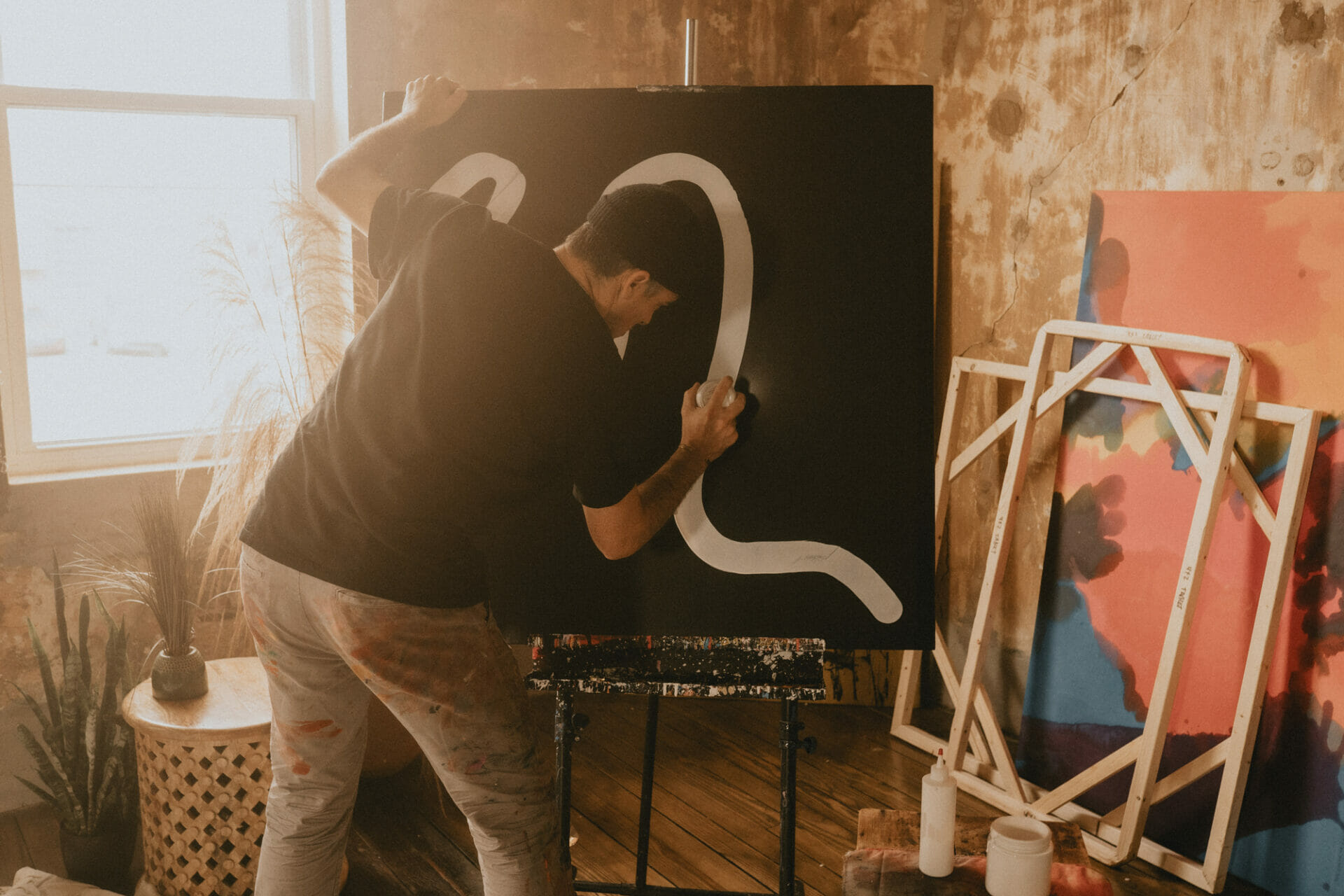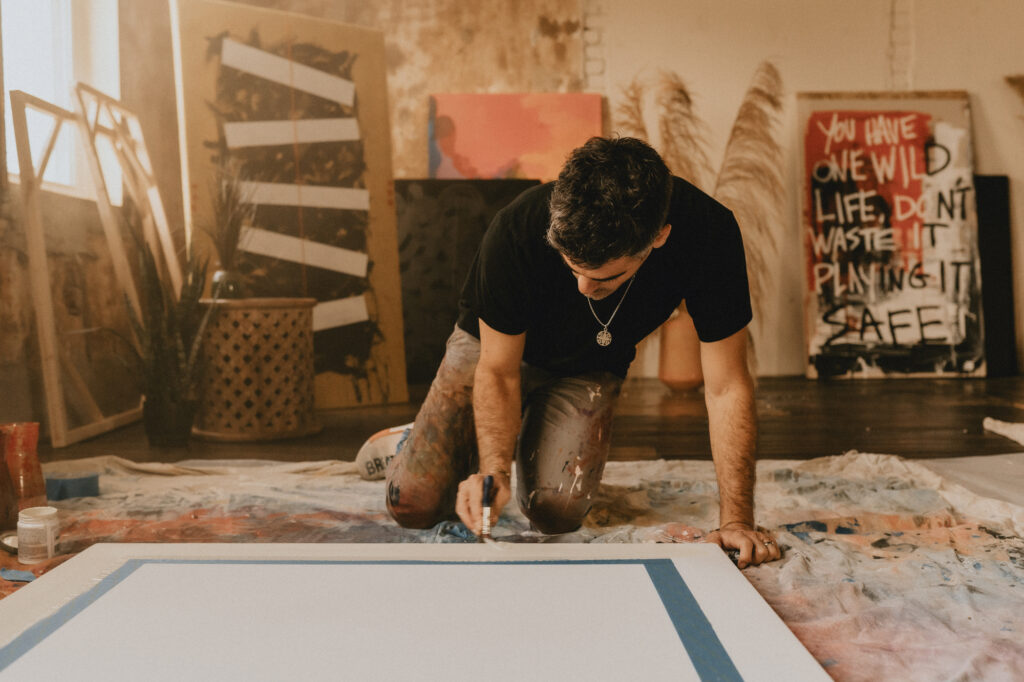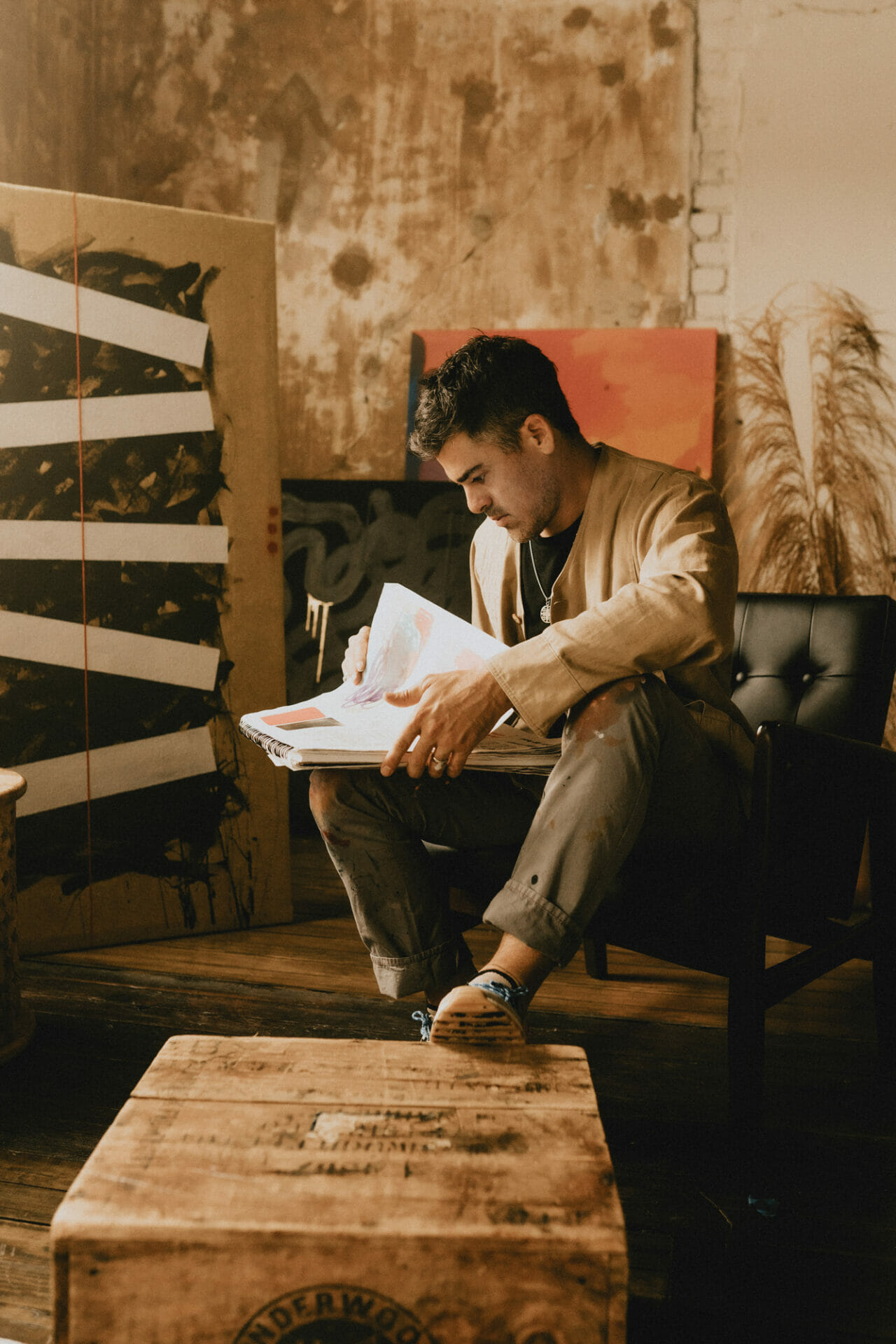Photography by Joshua Mcfarquhar
Lakeland artist Jason DeMeo is creating art on his own terms while growing commercial and entrepreneurial success.
The very act of walking into artist Jason DeMeo’s Lakeland home is a modernist art historian’s dream. From the décor (mid-century) and the motivational sticky notes plastered around the working areas to the art filling the walls, which runs the gamut from vaguely referential (think street art) to freely gestural (think 1950s Abstract Expressionism), it becomes immediately evident that you are in the space of a true creative. Once you talk to DeMeo, you realize his creative mind marks only the beginning of what makes him worthy of being called “Lakelander Made.”
Along with his wife Hillary, DeMeo is the co-founder of We Are Curio, a Lakeland-based “innovation studio” that uses design thinking to encourage out-of-the-box ideas and enable a better future for businesses and individuals.

Hillary DeMeo supports her husband’s journey as an artist.
The very act of walking into artist Jason DeMeo’s Lakeland home is a modernist art historian’s dream. From the décor (mid-century) and the motivational sticky notes plastered around the working areas to the art filling the walls, which runs the gamut from vaguely referential (think street art) to freely gestural (think 1950s Abstract Expressionism), it becomes immediately evident that you are in the space of a true creative. Once you talk to DeMeo, you realize his creative mind marks only the beginning of what makes him worthy of being called “Lakelander Made.”
Along with his wife Hillary, DeMeo is the co-founder of We Are Curio, a Lakeland-based “innovation studio” that uses design thinking to encourage out-of-the-box ideas and enable a better future for businesses and individuals.
Yet, while one aspect of DeMeo’s professional life is grounded in the family business, within moments of knowing him you learn that it is painting that offers DeMeo an important personal outlet of expression, exploration, and self-reflection to call his own.

Jason DeMeo is always experimenting with new materials and techniques.
Indeed, you don’t hear much about 21st-century male artists being inspired by Helen Frankenthaler these days. And perhaps this is why meeting DeMeo one rainy day in November was so refreshing for this modernist art historian. A Pennsylvania transplant to Lakeland since his days as a Southeastern University undergraduate, DeMeo has spent years considering the concept and expectations of masculinity — both in his life and in his art; Frankenthaler, meanwhile, was a female Abstract Expressionist defying all odds and making her name in a 1950s era where male artists dominated the art scene.
Frankenthaler (1928-2011) is best known as a Second-Generation Abstract Expressionist who pioneered the art of stain painting (inspired by the example of Jackson Pollock) in the early 1950s; that DeMeo finds in Frankenthaler his inspiration to delve into his own psyche and explore his creative self speaks volumes. As a visitor to DeMeo’s home — which he shares with Hillary, their daughter Ellie, and an adorable Welsh terrier Kennedy — quickly observes, DeMeo pays homage to Frankenthaler not just literally (as in the lushly colored Under the Influence of St. Helen, which hangs as a living-room centerpiece), but also in the consciously cerebral and, as he puts it, “low-tech” underpinnings of the expressive work he produces.
“I’m looking at the conceptual experience, but I also just love getting into the work, the color and action of painting,” DeMeo explains.

While traces of Frankenthaler are evident in some of DeMeo’s most gestural, poured-paint work, wherein colors seep into unprimed canvases placed horizontally on the ground, such that the resulting compositions are controlled by both the artist’s hand and by gravity, DeMeo has developed an aesthetic all his own. Stretching his own canvases and with touches of Keith Haring in his humorously dubbed Fruity Ramen works (think swirly, cartoony, colorful noodle-like forms filling up the picture plane) and Michel Basquiat in his text-based abstractions, DeMeo harks back subtly to artists who came before him but in new, novel, and clearly successful ways.
DeMeo is making a name for himself in Lakeland and in the art world by creating art that speaks foremost to himself, commercial considerations aside. That his work is receiving national acclaim, that he is using his Instagram presence smartly to gain gallery representation, and that his core motivation nevertheless remains to be concerned with self-edification and clarity underlines the sincere motivations of his practice. Does DeMeo want to sell his work and promote his business? Of course. Are sales why he does what he does? No — as evidenced by the peripatetic nature of his artistic exploration (not sticking to any one style) and his keeping most of his original works to hang on the walls of his own home.

DeMeo’s art practice seeks to create intersections between color, meaning, space, matter, concept, and emotion.
“I think to myself that I want to be an artist to make art but also to be able to afford to be an artist who can try new things,” DeMeo says. Now that he is represented by a gallery in Houston, which found his work via Instagram, DeMeo’s reach is widening, which, in turn, allows him to focus more on his core motivations.
“I try to synthesize my influences into something interesting, Ab-Ex, graffiti culture, Japanese art, hip-hop,” DeMeo says, but cautions that most important to him is using the space of art to reconcile his emotions and respond to the collective emotions of our era.
Many of his works feature quotes that ring the outer edges of his canvases and draw on lessons of our time. In Boys Don’t Cry?, a 3×5-foot stretched linen abstract painting, part of a series exploring masculinity, DeMeo scrawls a lengthy quote by actor Michael Ian Black around the perimeter: “Too many boys are trapped in the same suffocating, outdated model of masculinity … where manliness is about having power over others.”
With other paintings whose predominant color palettes are red, white, and blue and whose painted text includes “IT DOESN’T HAVE TO BE THIS WAY” or “MAKE AMERICA GOOD,” DeMeo elegizes other crises of our moment. If representational imagery will not help solve our bitter divides, perhaps the emotive qualities of color and gesturalism will? One can only hope. And DeMeo — fully engaged with his craft, whose heart lies in the need to peer inside and express oneself — may just help us all take a step toward better understanding ourselves and each other.
“I make work that is political but not partisan in nature,” he says.
Thus, despite its abstract nature, DeMeo creates a dynamic and refreshingly self-conscious art that is meant to make viewers feel something and that appeals across aesthetic and cultural divides. For him, painting “politically” is a means of catharsis, using the space of the canvas and “art to say something, to get a message out quickly.”
[modula id=”23653″]
So, in 2020, can you keep your purity as an artist but also survive as an artist? You could aim to do as DeMeo does. And here is where it all gets a bit trippy: Jason DeMeo the We Are Curio entrepreneur, is Jason DeMeo the artist, but also not. DeMeo produces his paintings under the name JASPACE, a pseudonymous attempt to separate, however moderately, DeMeo’s “artist-self” from his “self-self.” Creating his work under the signature of JASPACE is both an admittedly defensive means of self-protection and the makings of an overtly and admittedly marketable brand.
And to be certain, DeMeo has been deliberate in his creation and promotion of his art. He is both an artist’s artist to his core — wanting to make art because, above all else, it communicates to him — and aware of the ironic need to sell his art to continue pursuing and honing his craft. In fact, in an ideal world, DeMeo would have creative control but simultaneously be able to offer his art to wide audiences. As a bit of a compromise, he often makes multiples of his work: a buyer can commission him to create a second version of any piece he has made, identical in nearly every way but also often for less money than the original.
“I’m looking at the conceptual experience,
but I also just love getting into the work, the color and action of painting.”
For DeMeo, JASPACE is both a personal creative space, separable from the communal work of We Are Curio but also compartmentalized within the larger scheme of that business. A space to call his own within the family operation. And he foresees a day where the artwork he produces may be an increasing part of the consulting and design process (today, We Are Curio already leads art-making workshops to inspire design thinking in groups who hire the firm).
So, what makes Jason DeMeo “Lakelander Made”? Where does Jason DeMeo end and JASPACE begin? Where does JASPACE end and We Are Curio begin? The intrigue and success of DeMeo’s creative project is that it doesn’t matter. He’s creating art on his own terms. Conceptual and reflective thinking undergirds all DeMeo does, a continued process toward growth and innovation, and making art that motivates his viewers to aspire collectively for a better tomorrow.
